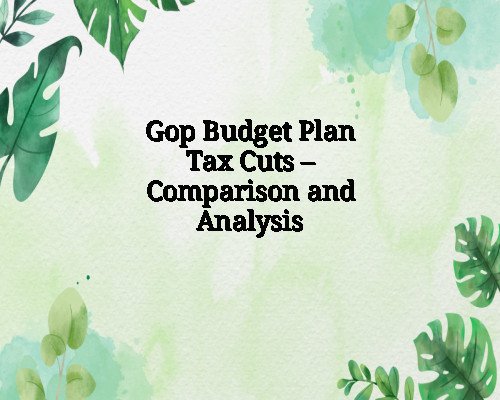GOP Budget Plan Tax Cuts – Comparison and Analysis
Explore how the GOP budget plan proposes tax cuts, their impacts on different income groups, and how they compare to past Republican tax strategies.
Introduction to the GOP Budget Plan
The GOP budget plan, a core policy framework for the Republican Party, focuses on reducing the size of government, decreasing federal spending, and implementing broad tax reforms. Central to these plans are proposed tax cuts aimed at stimulating economic growth, enhancing business investment, and simplifying the tax code. However, such proposals also generate intense debate regarding their long-term fiscal sustainability and equity.
In this analysis, we’ll break down the latest GOP budget tax cut proposals, compare them with past Republican tax plans (like the 2017 Tax Cuts and Jobs Act), and evaluate their implications for individuals, businesses, and the overall economy.
Key Features of the GOP Tax Cut Proposals
1. Extension of Individual Tax Cuts
The latest GOP plan seeks to make permanent several provisions from the 2017 Tax Cuts and Jobs Act (TCJA), including:
-
Lower individual income tax rates
-
Doubled standard deduction
-
Expanded child tax credit
-
Capped state and local tax (SALT) deduction
These provisions, originally set to expire in 2025, are a top priority for Republicans to extend, arguing that they benefit middle-class families and keep taxes low.
2. Corporate Tax Rate Reduction
The GOP plan often includes a commitment to keep or further reduce the corporate tax rate, which was lowered from 35% to 21% in the TCJA. The goal is to bolster U.S. competitiveness globally, attract foreign investment, and encourage domestic business expansion.
3. Capital Gains and Dividend Tax Reforms
Proposals typically favor reducing taxes on capital gains and dividends, aiming to encourage long-term investments and support retirement savings. Republicans argue this promotes economic growth by freeing up capital for investment.
4. Elimination of Certain Tax Credits and Deductions
While tax cuts are emphasized, the GOP plan often proposes eliminating or modifying specific tax credits and deductions deemed inefficient or overly complex. These include:
-
Renewable energy tax credits
-
Various business tax loopholes
-
Limiting itemized deductions further for high-income earners
Comparison with Previous GOP Tax Policies
The 2017 Tax Cuts and Jobs Act (TCJA)
The TCJA was the most significant GOP-led tax overhaul in decades. Key features included:
-
Slashing the corporate tax rate from 35% to 21%
-
Consolidating individual tax brackets
-
Doubling the standard deduction
-
Repealing the individual mandate penalty for health insurance
-
Introducing a 20% deduction for pass-through business income
Compared to the current GOP budget plan, the new proposals build directly on the TCJA, especially in making temporary provisions permanent and potentially cutting corporate taxes further.
The Bush-Era Tax Cuts (2001 & 2003)
Known as the Economic Growth and Tax Relief Reconciliation Act (EGTRRA) and Jobs and Growth Tax Relief Reconciliation Act (JGTRRA), these cuts:
-
Lowered income tax rates
-
Reduced taxes on capital gains and dividends
-
Phased out the estate tax
The GOP’s current proposals resemble these earlier efforts, focusing on across-the-board rate reductions and stimulating investment through favorable treatment of capital.
Who Benefits Most from the GOP Tax Cuts?
High-Income Earners
GOP tax cuts generally provide the most substantial benefits to higher-income households, especially through:
-
Reduced top marginal tax rates
-
Capital gains tax reductions
-
Increased estate tax exemptions
This is consistent with GOP ideology that favors supply-side economics, arguing that wealthy individuals and businesses are the key drivers of job creation and economic expansion.
Middle-Class Households
The GOP argues that middle-income families also benefit from:
-
Lower tax brackets
-
Larger standard deduction
-
Expanded child tax credits
However, critics argue that these benefits are relatively modest compared to those received by higher earners, especially after accounting for the expiration of some provisions.
Corporations and Small Businesses
Corporate America is a clear beneficiary, with lower corporate tax rates and deductions for pass-through income. Republicans assert this leads to:
-
Higher business investment
-
Increased hiring
-
Wage growth over time
Yet, analysis shows that much of the benefit is retained as shareholder value rather than directly boosting wages or jobs.
Economic Implications
Short-Term Stimulus
Tax cuts often provide a short-term boost to economic activity by:
-
Increasing disposable income
-
Enhancing business profitability
-
Stimulating consumer spending
However, the magnitude of this stimulus depends on the type of tax cut and the prevailing economic conditions.
Long-Term Deficit Concerns
A major criticism of GOP tax policies is their impact on the federal deficit. Unless accompanied by significant spending cuts or offsetting revenue increases, large tax cuts can balloon the national debt.
-
The TCJA, for example, added an estimated $1.9 trillion to the deficit over a decade.
-
Current GOP proposals could exacerbate this trend unless paired with entitlement reforms or discretionary spending reductions.
Supply-Side vs Demand-Side Debate
The GOP relies on supply-side economics, which posits that lower taxes spur growth and eventually offset lost revenue. Critics, however, argue that demand-side policies (targeted support to low- and middle-income groups) are more effective in a modern, consumer-driven economy.
Political and Public Response
Support Among Republicans
Republican lawmakers and many conservative think tanks support the budget plan’s tax provisions, emphasizing:
-
Economic freedom
-
Entrepreneurial growth
-
Smaller government
Tax reform remains a central pillar of GOP campaign platforms and is often used to differentiate from Democratic alternatives.
Opposition from Democrats
Democrats criticize the GOP tax cuts as regressive and fiscally irresponsible, arguing they:
-
Widen income inequality
-
Benefit the wealthy disproportionately
-
Undermine critical public investments (e.g., healthcare, education)
They favor higher taxes on the wealthy and corporations to fund expanded social programs.
Public Opinion
Polling shows mixed reactions. While many Americans support lower taxes in principle, opinions shift based on:
-
Perceived fairness of the cuts
-
Impact on services like Medicare and Social Security
-
Deficit concerns
Often, the complexity of tax policy makes public perception highly sensitive to political messaging.
Comparison with Democratic Tax Proposals
To better understand the GOP’s position, it helps to contrast with Democratic proposals:
| Policy Area | GOP Approach | Democratic Approach |
|---|---|---|
| Individual Income Taxes | Lower rates, especially for higher brackets | Raise top rates, expand EITC and credits |
| Corporate Taxes | Maintain or lower corporate tax rates | Raise rates to 25%-28%, close loopholes |
| Capital Gains | Preferential treatment (lower rates) | Tax as ordinary income for high earners |
| Estate Tax | Raise exemption thresholds or repeal it | Lower exemption, increase tax rate |
| Tax Code Complexity | Simplify by reducing deductions | Simplify but retain progressive structure |
This comparison highlights the philosophical divide: growth via lower taxes versus equity through progressive taxation.
Potential Long-Term Outcomes
Economic Growth
If GOP assumptions hold, tax cuts could:
-
Increase investment
-
Raise productivity
-
Lead to higher long-term GDP growth
But this depends on how businesses and consumers respond, and whether growth offsets revenue losses.
Income Inequality
Without targeted measures, GOP tax cuts may worsen income inequality. Critics argue that rising inequality undermines long-term economic stability and social cohesion.
Fiscal Sustainability
With aging populations and rising healthcare costs, tax cuts may constrain the government’s ability to fund essential services unless matched with spending reforms or new revenue sources.
Conclusion
The GOP budget plan’s tax cut proposals reflect a consistent ideological approach to fiscal policy: reduce taxes to stimulate growth, simplify the tax code, and promote business investment. While these measures can offer economic benefits, particularly for higher earners and corporations, they also raise concerns about equity and fiscal responsibility.
Understanding the full impact requires balancing short-term gains with long-term consequences — especially as debates over deficits, inequality, and economic competitiveness intensify in the coming election cycles.

